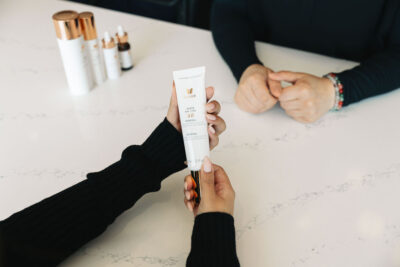September 3, 2024
Sun damage can have long-lasting effects on your skin, leading to various concerns such as dark spots, wrinkles, and uneven texture. Overexposure to the sun’s harmful ultraviolet (UV) rays can accelerate the aging process and increase the risk of skin cancer. Understanding how to treat sun-damaged skin is crucial for maintaining a healthy and youthful appearance.
We often take sunlight for granted, enjoying the warmth and the glow it provides. However, UV rays can penetrate the skin and cause damage at a cellular level. This damage accumulates over time, resulting in visible signs like fine lines, pigmentation, and even conditions like actinic keratosis (pre-cancerous lesions) and skin cancers.
Thankfully, there are numerous effective treatments available for sun-damaged skin. Whether you are dealing with mild discoloration or more severe changes, these treatments can help restore your skin’s health and vitality. From topical solutions to advanced laser therapies, understanding your options will empower you to make the best choices for your skin’s recovery. Regular skincare and professional treatments can significantly improve the appearance and health of sun-damaged skin, allowing you to enjoy a more radiant complexion.
Understanding Sun Damage
What Happens to Your Skin When It’s Sun-Damaged
Sun damage occurs when your skin is exposed to the sun’s ultraviolet (UV) rays without adequate protection. UV rays penetrate the skin and reach deep into its layers, causing damage to cells and tissues. This damage disrupts the normal functioning of skin cells, leading to various issues.
Over time, exposure to these rays breaks down collagen and elastin, the proteins that keep your skin firm and elastic. This breakdown results in wrinkles, fine lines, and sagging skin. Additionally, UV rays can affect the DNA in your skin cells, increasing the risk of skin cancer.
Signs and Symptoms of Sun Damage
You can identify sun damage by several visible signs and symptoms:
- Wrinkles and Fine Lines: These are often more pronounced in areas most exposed to the sun, like the face and hands.
- Hyperpigmentation: Dark spots or patches, also known as sunspots or age spots, appear on sun-exposed areas.
- Dry and Rough Skin: Sun-damaged skin often feels dry, rough, and flaky.
- Redness and Swelling: Prolonged exposure can cause redness, swelling, and even sunburn.
- Loss of Elasticity: Skin may lose its firmness and become saggy.
Recognizing these signs early can help in taking appropriate measures to address and treat sun damage.
The Importance of UV Protection
How UV Rays Harm Your Skin
UV rays from the sun are classified into two types: UVA and UVB. Both types can potentially cause harm to your skin. UVA rays penetrate deeper into the skin, contributing to premature aging and wrinkling. UVB rays are primarily responsible for sunburn and can damage the surface layers of the skin.
Repeated exposure to UV rays leads to cumulative damage, manifesting as various skin issues. The most severe consequence of prolonged UV exposure is the increased risk of developing skin cancer. Even short periods of exposure without protection can lead to significant damage over time.
Preventative Measures and Effective Sunscreens
Protecting your skin from UV rays is essential. Here are some effective preventative measures:
- Use Sunscreen: Always apply a broad-spectrum sunscreen with at least SPF 30 every day, even on cloudy days. Look for water-resistant formulas if you plan to swim or sweat.
- Wear Protective Clothing: Long sleeves, wide-brimmed hats, and sunglasses can shield your skin from direct sun exposure.
- Seek Shade: Whenever possible, stay in the shade, especially between 10 AM and 4 PM when the sun’s rays are strongest.
- Reapply Sunscreen: Reapply every two hours or immediately after swimming or sweating.
These measures can help minimize sun damage and protect your skin’s health.
Topical Treatments for Sun-Damaged Skin
Benefits of Retinoids and Vitamin C
Topical treatments are effective in managing sun-damaged skin. Retinoids, derived from vitamin A, promote cell turnover and help reduce the appearance of fine lines and wrinkles. They also encourage the growth of new, healthy skin cells, which can help reverse some damage caused by the sun.
Vitamin C is a powerful antioxidant that protects the skin from free radicals and environmental stressors. It brightens the skin and reduces the appearance of pigmentation, giving your skin a more even tone. Using products that contain these ingredients can significantly improve the look of sun-damaged skin.
How and When to Use These Products
To maximize the benefits of retinoids and vitamin C, follow these guidelines:
- Retinoids: Use retinoids in the evening, as they can increase your skin’s sensitivity to the sun. Start with a lower concentration to avoid irritation and gradually increase as your skin adjusts. Apply after cleansing and before moisturizing.
- Vitamin C: Incorporate vitamin C into your morning routine. Apply it after cleansing but before moisturizing and sunscreen. Vitamin C serums are effective as they deliver the ingredient in a concentrated form.
Consistent use of these products can yield visible improvements in sun-damaged skin over time.
Chemical Peels for Sun Damage
Different Types of Chemical Peels
Chemical peels are a popular and effective treatment for sun-damaged skin. They involve applying a chemical solution to the skin, which exfoliates and removes the damaged outer layers. Various types of chemical peels cater to different levels of severity:
- Light Peels: Use mild acids like alpha hydroxy acid (AHA) to exfoliate only the outer layer of skin. Suitable for improving texture and minor pigmentation.
- Medium Peels: Utilize stronger acids, such as glycolic or trichloroacetic acid, to reach the middle layers of skin. Effective for treating wrinkles, pigmentation, and texture.
- Deep Peels: Use potent acids like phenol to penetrate the deeper layers of the skin. Best for severe sun damage and pronounced wrinkles but require more recovery time.
Benefits of Chemical Peels for Sun-Damaged Skin
Chemical peels offer several benefits for sun-damaged skin:
- Improved Skin Texture: They remove the damaged top layers, making your skin smoother and more even.
- Reduced Pigmentation: Peels can diminish dark spots and sunspots, giving your skin a more uniform appearance.
- Enhanced Collagen Production: Stimulating collagen production helps firm the skin and reduce the appearance of fine lines and wrinkles.
- Quick Results: You can see noticeable improvements in your skin’s appearance in a relatively short period.
Chemical peels can effectively rejuvenate sun-damaged skin, promoting a healthier and more youthful complexion.
Laser Therapy Options for Sun-Damaged Skin
Types of Laser Treatments Available
Laser therapy is a highly effective method for treating sun-damaged skin. There are several types of laser treatments available, each targeting different aspects of sun damage:
- Fractional Lasers: These lasers create tiny columns of treated skin while leaving surrounding areas untouched, promoting faster healing. They are excellent for reducing wrinkles and improving skin texture.
- Non-Ablative Lasers: These lasers heat the inner layers of the skin without damaging the surface, stimulating collagen production and tightening the skin. They help in treating fine lines and minor sunspots.
- Ablative Lasers: These lasers remove the outer layers of the skin, making them ideal for severe sun damage. They can reduce deep wrinkles and significant pigmentation but require a longer recovery time.
How They Work to Repair Sun Damage
Laser treatments work by using focused light energy to remove or repair damaged skin cells. The treatment stimulates the skin’s natural healing process and boosts collagen production. Increased collagen can help firm the skin, reduce wrinkles, and improve overall texture. The procedure can also target pigmentation issues, breaking down dark spots and promoting more even skin tone. Laser therapy is precise and can yield significant improvements in the appearance and health of sun-damaged skin.
Microdermabrasion and Dermabrasion
Differences Between the Two Procedures
Microdermabrasion and dermabrasion are both exfoliating treatments, but they differ in their approach and intensity:
- Microdermabrasion: This is a minimally invasive procedure using fine crystals or a diamond-tipped wand to gently exfoliate the outer layer of the skin. It’s ideal for treating mild sun damage, improving texture, and reducing minor dark spots.
- Dermabrasion: This is a more intensive procedure that uses a rotating instrument to remove deeper layers of skin. It’s effective for treating more severe sun damage, deep wrinkles, and prominent pigmentation issues.
Effectiveness in Treating Sun Damage
Both procedures are effective in addressing sun-damaged skin, but their effectiveness depends on the severity of the damage:
- Microdermabrasion: Best for surface-level damage, this treatment can improve overall skin brightness, reduce fine lines, and smooth texture with minimal downtime. It’s a good option for maintaining healthy skin and addressing early signs of sun damage.
- Dermabrasion: Suited for more significant damage, this treatment can yield more dramatic results. It can effectively reduce deep wrinkles, scars, and extensive pigmentation, but it comes with a longer recovery period.
Considering your skin’s condition and consulting with a dermatologist will help determine the most suitable option.
Intense Pulsed Light (IPL) Therapy
How IPL Treats Sun-Damaged Skin
Intense Pulsed Light (IPL) therapy is a versatile treatment that uses broad-spectrum light to target sun-damaged areas. Unlike lasers, which use focused light, IPL delivers multiple wavelengths, allowing it to treat various skin issues simultaneously. The light energy penetrates the skin and is absorbed by pigmented cells and blood vessels, breaking down pigmentation, reducing redness, and stimulating collagen production.
What to Expect During and After Treatment
IPL therapy is relatively quick and involves minimal discomfort. Here’s what you can expect:
- During Treatment: A cooling gel is applied to the skin, and protective eyewear is provided. The IPL device is then passed over the treatment area, emitting pulses of light. You might feel a slight snapping sensation, similar to a rubber band against the skin.
- After Treatment: Mild redness or swelling may occur but typically subsides within a few hours. Over the next few days, pigmented spots may darken before gradually fading. Multiple sessions are usually needed for optimal results.
By following your dermatologist’s post-treatment care instructions, you can achieve clearer, more even-toned skin.
Hydroquinone for Hyperpigmentation
How Hydroquinone Lightens Dark Spots
Hydroquinone is a powerful skin-lightening agent commonly used to treat hyperpigmentation caused by sun damage. It works by inhibiting the enzyme responsible for melanin production, the pigment that gives skin its colour. By reducing melanin production, hydroquinone helps lighten dark spots and create a more even skin tone.
Safe Usage and Potential Side Effects
While hydroquinone is effective, it’s important to use it safely to avoid side effects:
- Usage: Apply hydroquinone to clean, dry skin, preferably in the evening. Use it only on the affected areas and follow with a moisturizer to prevent dryness. Always use sunscreen during the day, as hydroquinone can increase sun sensitivity.
- Side Effects: Some users may experience mild irritation, redness, or dryness. If these symptoms persist, discontinue use and consult with a dermatologist. Prolonged use should be monitored to prevent complications like ochronosis, a condition that causes blue-black pigmentation.
By following guidelines and seeking professional advice, hydroquinone can effectively reduce hyperpigmentation and improve skin clarity.
Antioxidant-Rich Skincare Routine
Role of Antioxidants in Repairing Sun Damage
Antioxidants play a crucial role in protecting and repairing sun-damaged skin. They neutralize free radicals, which are unstable molecules that cause damage to cells, thereby reducing inflammation and promoting skin healing. By incorporating antioxidants into your skincare routine, you can support your skin’s natural repair processes and enhance its resilience against further damage.
Recommended Products and Ingredients
Here are some key antioxidant ingredients to look for in your skincare products:
- Vitamin C: Brightens the skin, reduces pigmentation, and stimulates collagen production.
- Vitamin E: Moisturizes and protects the skin from oxidative stress.
- Green Tea Extract: Soothes the skin and provides strong antioxidant protection.
- Resveratrol: Found in grapes, this ingredient helps in fighting signs of aging and improving skin texture.
Using serums, moisturizers, and masks containing these ingredients can help repair and rejuvenate sun-damaged skin.
Moisturizing and Hydration
Importance of Keeping Sun-Damaged Skin Hydrated
Keeping sun-damaged skin properly hydrated is essential for its repair and overall health. Moisturizing helps to restore the skin barrier, which can be compromised by UV exposure, leading to dryness and increased sensitivity. Well-hydrated skin is more resilient and better able to heal from the damage caused by the sun.
Best Moisturizers and Hydrating Serums
Here are some recommended types of moisturizers and hydrating serums:
- Hyaluronic Acid: Known for its ability to hold up to 1,000 times its weight in water, it deeply hydrates and plumps the skin.
- Ceramides: These are lipids that help restore the skin barrier, keeping it healthy and hydrated.
- Glycerin: An excellent humectant that draws moisture into the skin.
- Aloe Vera: Calms and hydrates irritated and sun-damaged skin.
Using products containing these ingredients can keep your skin soft, supple, and better equipped to recover from sun damage.
Healing Diet and Supplements
Foods That Promote Skin Healing
A balanced diet rich in nutrients is vital for skin health. Here are some foods that can promote skin healing and rejuvenation:
- Fruits and Vegetables: Rich in vitamins A, C, and E, antioxidants, and minerals that support skin repair.
- Fatty Fish: Contains omega-3 fatty acids that reduce inflammation and keep the skin moisturized.
- Nuts and Seeds: Provide essential fatty acids and vitamin E, which protect and repair the skin.
Beneficial Vitamins and Supplements
Including the following vitamins and supplements can support skin repair from within:
- Vitamin C: Boosts collagen production and repairs damaged skin.
- Vitamin E: Protects the skin from oxidative damage and supports healing.
- Omega-3 Fatty Acids: Reduce inflammation and keep the skin hydrated.
Incorporating these foods and supplements into your daily routine can enhance your skin’s ability to heal and stay healthy.
Long-Term Maintenance and Prevention
How to Maintain Healthy Skin After Treatment
Maintaining healthy skin after treating sun damage requires a consistent and protective skincare routine. Here are some tips for long-term maintenance:
- Continue Using Sunscreen: Daily use of sunscreen with broad-spectrum protection and at least SPF 30 is essential.
- Regular Exfoliation: Helps remove dead skin cells and promotes the renewal of healthy skin.
- Consistent Hydration: Keep your skin hydrated with moisturizers and serums.
Ongoing Protective Measures and Regular Check-Ups
To prevent future sun damage, follow these protective measures:
- Wear Protective Clothing: Long sleeves, wide-brimmed hats, and UV-protection sunglasses.
- Seek Shade: Avoid direct sunlight, especially during peak hours.
- Regular Derm Check-Ups: Schedule regular skin exams with your dermatologist to monitor any changes in your skin.
Implementing these practices will help you maintain healthy, glowing skin and prevent further damage.
Sun damage can significantly affect your skin’s health and appearance, but various treatments can help repair and restore it. From laser therapies and chemical peels to topical antioxidants and proper hydration, there are numerous ways to improve sun-damaged skin. Additionally, maintaining a nutrient-rich diet and consistent sun protection will support your skin’s long-term health.
By adopting a comprehensive skincare routine and taking preventative measures, you can protect your skin from future damage and enjoy a youthful, radiant complexion. Looking after your skin is an ongoing commitment, but the results are undeniably rewarding.
If you’re ready to enhance your skincare routine or need professional advice, visit VIDA Dermatology. Our skin specialist in Edmonton is here to help you achieve the best skin possible. Schedule a consultation today!



